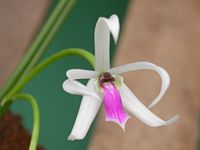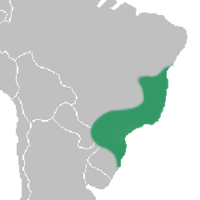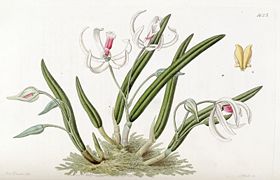Leptotes (orchid)
| Leptotes | ||||||||||||||||||||
|---|---|---|---|---|---|---|---|---|---|---|---|---|---|---|---|---|---|---|---|---|
 Leptotes bicolor
| ||||||||||||||||||||
| Scientific classification | ||||||||||||||||||||
| ||||||||||||||||||||
| Type species | ||||||||||||||||||||
| Leptotes bicolor Lindl. 1833 | ||||||||||||||||||||
| Species | ||||||||||||||||||||
| ||||||||||||||||||||
| Synonym | ||||||||||||||||||||
|
None |
Leptotes is a genus of orchids formed by nine small species of Brazil which exist in the dry jungles of South and Southeast, and also in Paraguay or Argentina. They are small epiphytic plants of caespitific growth, that sometimes resemble little Brassavola, as they share same type of thin terete leaves, however, they are more closely related to Loefgrenianthus.
Some species of Leptotes are widely cultivaded and form showy displays when completely in bloom, yet the majority of species are not commonly found under cultivation, some are rare or even almost completely unknown. Five species have only been described after year 2000. They are not included among the orchids easiest to grow. Beside being cultivated for their ornamental value, there are records of eventual uses of the flowers and fruits of Leptotes bicolor as milk, ice cream, tea and candies aromatizers instead of Vanilla.[1]
Distribution
The species of Leptotes are originary from Atlantic Forest of Brazil, two species also found in other countries, L. unicolor in Argentina, and L. bicolor in Paraguay, always living epiphyticaly. Three species show high degree of endemism in the South of Bahia State, these do not exist in any other places. The distribution of one species is only an assumption. The states southeastern of Brazil are the ones that present the highest level of species occurrence, however, the extreme limits of distribution range from the Serra da Jibóia chain of mountains, in Bahia, to the North of Rio Grande do Sul State.[2]
The species of the group of wide open flowers, as Leptotes tenuis and L. pauloensis, are more frequent in cloud mountain forests. L. bicolor is the species most spread out and adaptated both to cloud mountanin forests and to the dryer woods of plateaus above of Serra do Mar chain of Mountains. Leptotes unicolor is a plant from coller areas, above 700 meters of altitude, frequently found growing on Araucaria and Podocarpus trees in the Southern areas of Brazil.[2]
Description
The species assigned to the genus Leptotes are plants of short rhizome, of cylindrical section, with very small pseudobulbs that almost imperceptibly prolongate in one, rarely two, short or long, erect or hanging, terete fleishy leaves, of dark green or purple colors, frequently presenting wrinkly surfaces, with a more or less deeper ridge in the face. The inflorescence is apical, generally short, and grows from the apex of the pseudobulb, without a protecting spathe, bearing one to seven flowers, however two or three are more common. The flowers are relatively large when are compared to the plant dimensions, normally partially bent, in some species forming groups of very showy aspect.[2]
Their flowers generally are of different shades of pink, greenish or white, with lip spotted of pale yellow, light purple or lilac, perfumed, which last from ten to twenty days.[3] The petals and sepals are similar, elongated, of the same color, the petals slightly narrower than the sepals. The lip is located along the column, trilobated, with small lateral lobes, raised aside of the column, however never involving it, or flat; the intermediate lobe is much bigger than the lateral ones, showing lanceolated or obovated format, occasionally fleishy, flat or bending backwards; in some species with denticulated edges, in other with smooth ones; rarely calli are present and it has claws wich hold it attached to the sides of the column. This is short, thick and erect, normally greenish, biauriculated, and bears six pollinia of different sizes, two larger in the center and four smaller in two pairs hold by a short caudicle, in an arrangement without similar among the orchids. Their fruits are rounded, succulent and perfumed as the ones of Vanilla.[4]
Leptotes pollination has never been observed and the assumptions about its agents are different, Cássio van den Berg assumes that, because of the colors and morphology of its flowers, they might be pollinated by bees,[2] while other orchidologists indicate the possibility of hummingbird pollination.[3]
Taxonomic notes
In April of 1833, it blossomed in the greenhouse of Mrs. Arnold Harrison, English collector of orchids homaged in diverse descriptions of noted species such as Bifrenaria harrisoniae and Cattleya harrisoniana an unknown species that she had received from Serra dos Órgãos mountains, in Brazil. Little time later, Mrs. Harrison sent a drawing and cut of this plant to the botanist John Lindley, who verified to be a new species. In its description, dated of the same year, Lindley suggests the name of Leptotes, of Greek, mild, delicate, in reference to the appearance of the flowers of this plant. He affirms that Leptotes is similar and close to Tetramicra from which it is distinguished by the structures of the pollinarium and by the lateral lobes of the lip of its flowers, much smaller; and because they have no calcar attached to the ovarium. He also explains that from Brassavola it can be differentiated by the pollinia and trilobed lip. Then Lindley describes its type-species, Leptotes bicolor.[5]
References
- ↑ Lawler, L.J.: Ethnobotany of the Orchidaceae in Orchid biology: reviews and perspectives, Vol.3. J. Arditti Ed., Cornell University Press, Ithaca, New York, 1984.
- ↑ 2.0 2.1 2.2 2.3 Van den Berg, Cássio: Leptotes in Genera Orchidacearum Vol.4, pp. 271-3. Oxford University Press, 2006. ISBN 9780198507123.
- ↑ 3.0 3.1 Miller, David; Richard Warren; Izabel Moura Miller & Helmut Seehawer: Serra dos Órgãos sua história e suas orquídeas, p. 240. Rio de Janeiro, 2006.
- ↑ Withner, Carl Leslie: The Cattleyas and Their Relatives, Vol. 3, pp.94-95. Timber Press, Oregon. ISBN 0881922692
- ↑ Lindley, John: Leptotes bicolor in Edward's Botanical Register Vol.19, t.1625. James Ridgway & Sons Ed. London, 1833. Published on internet.


